
Companies that consider themselves technological, modern and successful should strive for automation and rapid digital transformation. Where to start the path of change and digitization of processes? In order not to start automating chaos, first and foremost, articulated business processes are needed.
The driving force of any company is its business processes. The power of interaction between people, teams, systems and technologies. When a company moves from a startup to a certain level of complexity, it is indispensable to build and optimize these processes in order to further develop.
What the company management system consists of
Any company management system can be broken down into the following elements:
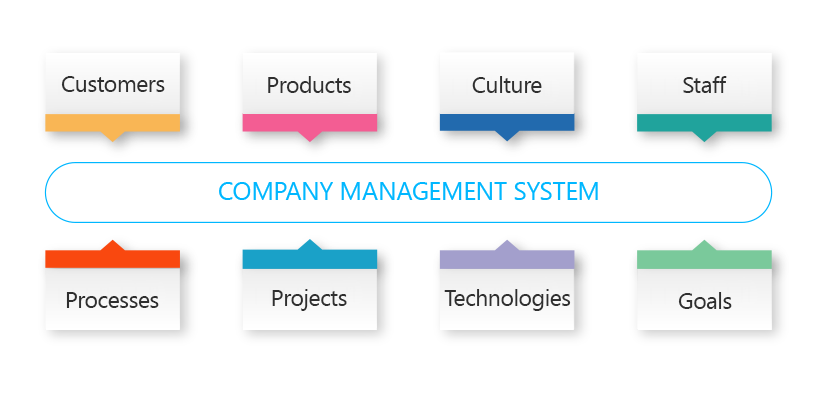
As soon as the issues of business accelerating, optimizing, scaling and making it flexible arise, as soon as the owners are ready to start fundamental changes and progress, the moment comes to think about using the BPM model.
It is often that companies have their business processes laid down in some form. In most cases, they are either in the employees’ heads, or, at best, outlined on paper. This large, complex and cumbersome set of documents takes several months of work of many departments and expends a huge amount of resources. Then it happens that after a couple of months, everyone forgets about the document and performs all the same chaotic functions they did before. All this not only does not contribute to the implementation of the change strategy, but also generally slows down the work of each unit and makes it unbearable.
Companies need to implement continuous modifications and changes in order to grow or remain at the same level, for example, to maintain sales figures. This applies to changes in customer interaction processes, changes in the production or delivery of materials, etc. The skill of adaptation is especially relevant for companies that operate in rapidly changing markets. And the top priority is to adapt the work processes of a company.
Processes and their types
A process is a combination of all the actions required to achieve a goal and a result. All company processes can be classified according to 2 main criteria:
- localization – relating to the design of interaction architecture that permeate the entire company and can cross the boundaries of several business units and interact with customers or contractors;
- added value – those generating company’s income.
The types of localization processes articulated with BPMN 2.0, as well as brief description of added-value processes, are presented below.

Local. Processes inside departments

Cross-functional. All intersecting processes and groups affect a lot of people, departments and tools
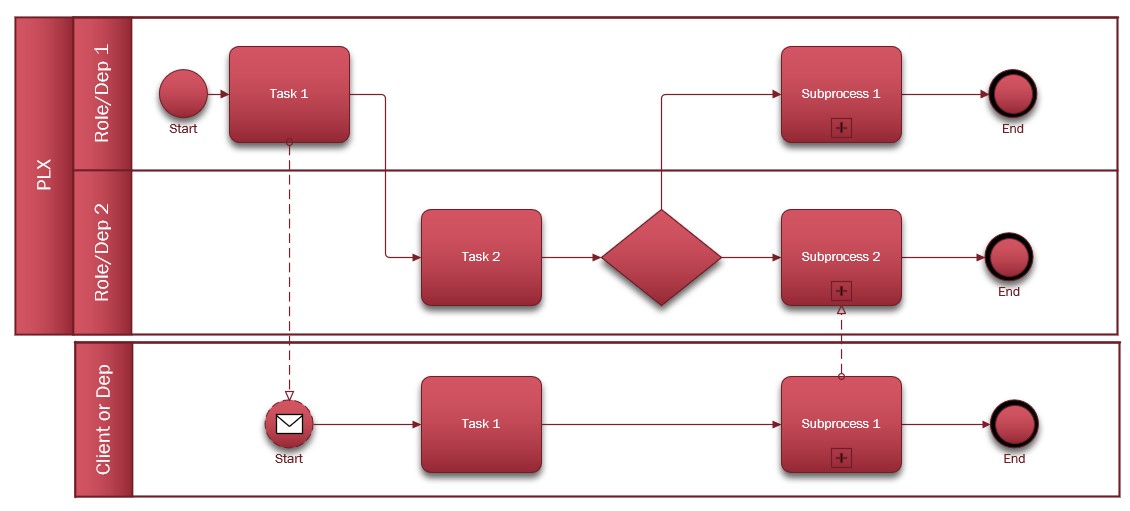
Cross-organizational. The main process of a company’s activities, which is synchronized with the processes of another company (can cross the boundaries of the company through the exchange of information or goods). The process may be related to a customer or contractor
Added-value processes:
- Main. Those directly resulting in making money.
- Supporting. Those ensuring making money.
- Managerial. Those coordinating making mone.
- Development processes. Strategic and project management.
It is worth mentioning that in order to change a process, resources, tools and procedures are required for launching and controlling the project. Clearly defined rules and standards based on which this will be implemented are needed too.
Speaking of digitization, each process that affects profitability or a supporting process should be articulated under the BPMN standard. The BPMN standard is the most modern format for describing business processes, which was formed at the junction between business and IT technologies. This is a direct link between processes and the tools these processes work with. Neither texts, nor IDEF diagrams are so effective for detailed activity modeling and automation.
BPM: approach and purpose
When we are talking about processes, we imply a certain system of work. BPM is a classic cyclical system with business processes inside.
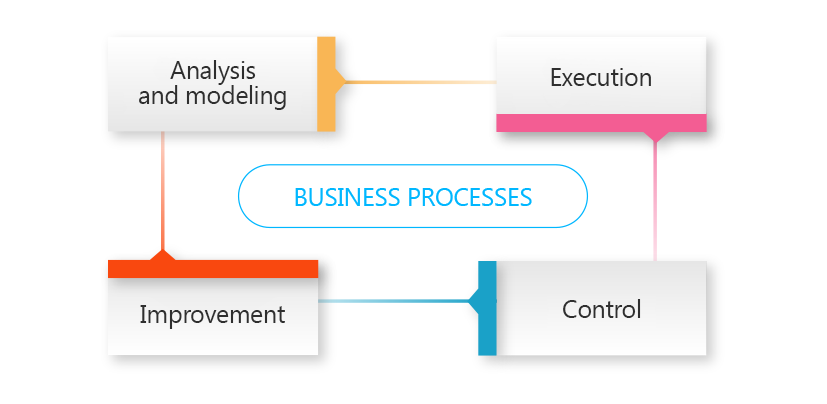
To build, change or supplement a business process, it is necessary to:
1. Analyze and model the process. See how the process should work, how it is better to change it or synchronize it with other processes of the organization (especially with those real money-making depends on). Processes are best described in certain standards: eEPC, VAD, CFD, BPMN, DMN, CMMN, that is, in notations that impose certain rules of description. The company must clearly and completely unambiguously understand how this process works, what its main components are and how this process can be changed if necessary. Process indicators are also set at this stage.
2. The process must next be executed. It is virtually impossible to create a perfect business process, so work with it will always be cyclical, that is, there will be certain shortcomings in any executable process, which will have to be eliminated over time
3. Execution control. This stage is necessary for understanding weaknesses, bottlenecks, underloads or overloads. For example, by measuring the speed of a process, determining its KPIs and evaluating each process in terms of money, the company receives an objective analysis of the enterprise viability. For example, shortening the process of production and delivery of a product can bring enormous profits to the enterprise and ensure a competitive advantage. Control is necessary to understand what is happening with the process.
4. When control is performed and results are received, it is possible to start comparing the KPIs set at the modeling stage and its real indicators. However, it is worth mentioning that the comparison and improvement cycle does not have a clear and definite ending. This is a process that, due to circumstances and internal and external factors, can, and should, last indefinitely.
Business process management is a modern trend that makes it possible to organize a company in terms of how the chains of interaction between people, mechanisms and software should function, regardless of which unit these process elements are in. This is the main task of BPM.
BPM goals
First of all, processes are displayed (modeled) exactly as they will be performed. It is appropriate to use the expression “Read as spelled”, and in our case “Work as described”. The key goals of BPM are as follows:
1. Process formalization and analysis – work as described. This is one of the BPMS system functions: working strictly according to the articulated scenario, i.e. model.
2. Continuous cyclical actions to optimize processes and their KPIs (errors, cost, duration, etc.). Optimization of activities, supply chains, production, procurement. Up to building interaction between people, which, as we have already learnt, is also a process.
3. Reducing the period of introducing new processes.
4. Reducing the period of modifying the existing processes.
5. Redistribution of management efforts from coordination of actions to functional responsibilities. A huge amount of time of highly qualified employees is spent not on work, but on coordination of actions and clarification of the process of work with other departments. The reason behind this is the lack of formalization of processes, as well as lack of understanding of what to do if an action affects several departments. Without a centralized cross-functional function, processes permeating an entire company do not work.
6. Decreasing dependency on the line personnel. The vast majority of actions are standard and can be described according to certain rules. This will free management from the constant need to explain standards and rules of work.
7. Maximum process automation (where appropriate). As well as minimizing processes that cannot be algorithmized. This makes it possible to reduce expenses, time expenditure, cost of project implementation and make them as transparent as possible.
8. Reducing management costs. By recording all processes and results, the management costs of all functions are reduced and there is the possibility of receiving reports on the real state of affairs in the company.
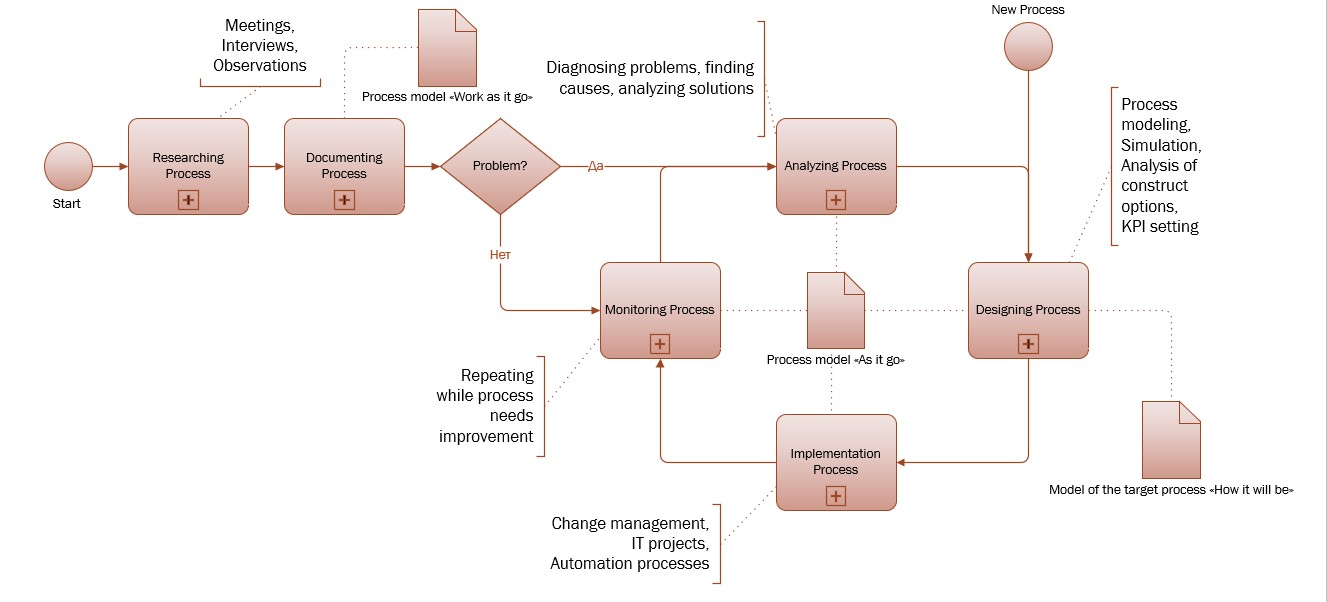
Example of a BPM cycle described in the BMPN 2.0 standard
IT tools for process management. BPMS
The undescribed process of switching to automated systems is a waste of money and time. Before implementing BPM methods and using IT tools, companies need to:
- understand how the process functions: inputs, outputs, resources;
- determine the type of work that is performed: manual, automatic, semi-automatic, purely creative;
- agree on a decision-making algorithm, as well as what data it is based on.
All these issues must be formalized and described. Having standardized these functions, using IT tools for process management can be considered.
BPMS – Business Process Management Suite (System) – is a junction between business and IT technologies.
With the advent of the BPMN (Business Process Model and Notation) standard, which was developed to synchronize IT and business, BPMS systems appeared. This was the next development step after the introduction of automated customer relationship management systems (CRMs) and systems for automating enterprise resource planning (ERPs). It should be noted that these are not alternatives to CRM and ERP, but a mechanism for their evolution. BPMS is a package, a class of business process management software products that implements the following tasks:
1. Organization of staff interaction in the framework of formalized processes.
2. Orchestration of the functioning of various software products in the framework of formalized processes.
3. Formalization, analysis, control and optimization of business processes of the organization.
4. Application of standards in the formalization of processes (BPMN / DMN / CMMN), which makes it possible to connect business and IT.
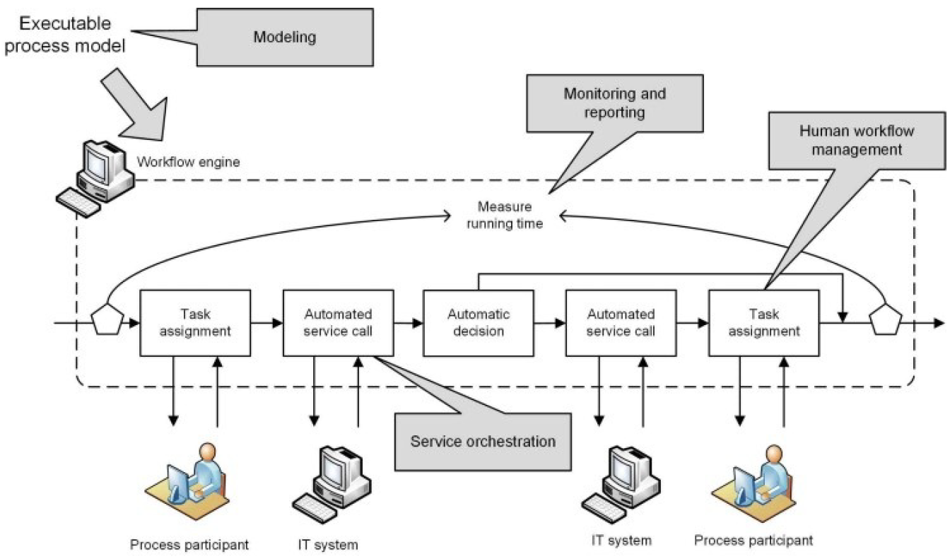
BPMS work architecture
What BPMS does. BPMS automatically converts the process outlined in BPMN into code, after which the code is “transformed” into real tasks for real employees. The output is a working process created without human intervention. Business analysts, management, or business process owners formalize the business model and elaborate it as much as required, very often down to the elementary functions. For example, a workshop employee moves products along a strictly defined route. Also, work can be performed not by a person, but by a system and be algorithmized.
BPMS consists of the same modules as the BMPN model. These are the modules responsible for:
- outlining processes, assigning tasks to employees (BMPS integrates with any other software products, receives and sends data );
- control of task performance (process KPIs and execution dynamics);
- work optimization (determine where in the process problems or other inconsistencies occur).
BPMS is an add-on for all other systems that demonstrates the coherence of all company processes. It is implemented to automate individual processes or to manage the entire company.
Software package of the low-code iBPMS class Camunda makes possible to put the BPM concept into practice from process development to process optimization. In Camunda, it is possible to fully visualize the real business processes of any organization. More details.
